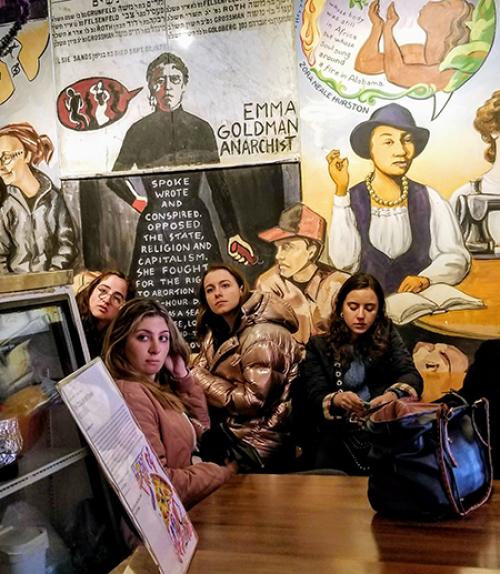Students in the undergraduate seminar “Lower East Side: Jews and the Immigrant City” came to New York City to directly experience the famous neighborhood’s history as well as learn about its contemporary challenges. AAP graduate students enrolled in a Mellon seminar on urbanism taught by Professor Pedro Erber joined the Jewish Studies class on March 24th, sparking vibrant discussions between students and faculty on the role that urban planning, renewal, community activism and housing play in immigrant life. As they walked the streets, students learned about the Lower East Side’s historically overcrowded tenement conditions that sparked rent strikes and changes to New York City’s building code.
The day started at the Essex Street Terminal Market, one of the last of its kind left in New York City. Created by Mayor LaGuardia, it was built to ensure that pushcarts were taken off the streets by placing vendors into a supervised enclosed space. The market is closing in April 2019 and its remaining vendors will move to a new space in Essex Crossing, a large new development. Next, a visit to a community garden illustrated how the neighborhood hit its nadir in the 1960s and how its burnt-out tenement lots became the basis for an urban gardening movement that helped reclaim the area for residents. Both gentrification and persistent poverty were visible as the students walked through the neighborhood, and became threads in understanding its current challenges.
A visit to a rare tenement synagogue gave students the opportunity to learn about its young congregation, see a community art exhibit now housed in its erstwhile women’s gallery, and learn about historical Jewish migration and immigrant societies. Students then visited a former synagogue that had become a community center after the congregation sold the building: the restoration of its memorial plaques was accompanied by the creation of new community murals. Its successful adaptive reuse serving neighborhood youth now allows for after-school programs and a community supported agricultural program providing neighborhood residents with well-priced, fresh healthy food direct from upstate farms.
After walking through Chinatown and learning about its communities, students visited the Museum of the Chinese in America (MOCA) to see Maya Lin’s new architectural makeover of the Museum’s space. MOCA provided a special tour led by a Cornell graduate in Asian Studies, who guided students through gallery spaces and provided the context for the history of “Chinatowns” in the wake of the Federal Chinese Exclusion Act of 1882.
The next day, a small group of students, faculty and alumni from Cornell and NYU participated in Triangle Fire commemoration activities, including chalking and lighting yahrtzeit candles outside of the erstwhile Lower East Side tenement residence of Julia and Israel Rosen, the only mother-son pair to die in the 1911 fire. Participating in a chain of memory and transmission of a story of Jewish and Italian immigrants allowed archival materials the students studied at the ILR School’s Kheel Center to come alive.





